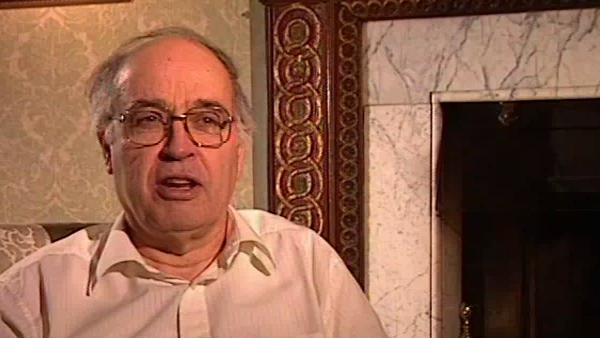NEXT STORY

Almost beaten by Manin
RELATED STORIES

NEXT STORY

Almost beaten by Manin
RELATED STORIES


|
Views | Duration | |
|---|---|---|---|
| 61. Lacunas and hyperbolic equations | 551 | 04:01 | |
| 62. Further research on lacunas | 443 | 02:36 | |
| 63. Instanton | 1 | 628 | 03:25 |
| 64. Evolving story of instantons | 528 | 02:38 | |
| 65. Almost beaten by Manin | 929 | 01:31 | |
| 66. Euclidian version of twistor theory | 636 | 02:08 | |
| 67. Collaborating with physicists | 1239 | 02:08 | |
| 68. The lack of a background in physics | 1 | 1229 | 02:02 |
| 69. Three manifold invariants | 790 | 02:55 | |
| 70. Individual contributions | 675 | 01:02 |


My original, you know, first work was on bundles on... on algebraic curves, and that's what I did… part of my thesis was about, right at the beginning when I began. And then after that my first, one of my early students, Rolph Schwarzenberger, I got him… gave him the work as a job, looking at bundles over […] space. He made some useful contributions. So, I... I knew a bit about bundles on... on projective spaces. I mean, there wasn't a great deal known, I mean the general theory; but it was, you know, it was a familiar problem. I knew what... I knew what these things sort of were, and of course more work had been done independently by algebraic geometers of which I was aware, and I knew that people like Horrocks and others that had been working on these things recently. So as soon as it was realised that this was a translation, I knew there was a body of... of work available, and techniques which one could try to... to bring to bear on it, which… otherwise, of course, it wouldn't have been much progress.
But it was clear that... that the classical problem of a kind that... that one should be able to tackle by various... various methods. And of course that's what... that’s what happened. When we pursued it further these... these techniques for constructing… well, originally the... the first thing that emerged was this… which I did with that paper of Richard Ward where there were these… this conception of Serre's which associates curves to rank two bundles as the zeros of cross-sections. And so we knew that you can construct bundles by curves of various kinds, and the first curves are the straight lines and that was what the physicists had already done.
Actually it was rather… slightly irritating, because I remember when we did this, my very first observation is, ‘Aha, we can... we can suddenly construct more instantons this way’. And I was… but then the next day some pre-print arrived from some physicists where they'd done that, and I… it was a bit... bit frustrating. And one or two... one or two other things that we did, the first easy ones, we found the physicists by their own methods had got there the same time. But then, pushing over much more complicated things it was clear one had a systematic approach, even if not very computational.
So it was clear that... that this was actually linked in with interesting questions in algebraic geometry, as soon as one realised what the problem was. And then later on using more sophisticated techniques with Horrocks' work, we ended up with the explicit construction in parallel with Drinfeld and Manin. So it... it was a sort of evolving story, but it was a part of the sort of long term collaboration which we'd already established with Roger in the first place.
Eminent British mathematician Sir Michael Atiyah (1929-2019) broke new ground in geometry and topology with his proof of the Atiyah-Singer Index Theorem in the 1960s. This proof led to new branches of mathematics being developed, including those needed to understand emerging theories like supergravity and string theory.
Title: Evolving story of instantons
Listeners: Nigel Hitchin
Professor Nigel Hitchin, FRS, is the Rouse Ball Professor of Mathematics and Fellow of Gonville and Caius College, Cambridge, since 1994, and was appointed to the Savilian Professorship of Geometry in October 1997. He was made a Fellow of the Royal Society in 1991 and from 1994 until 1996 was President of the London Mathematical Society.
His research interests are in differential and algebraic geometry and its relationship with the equations of mathematical physics. He is particularly known for his work on instantons, magnetic monopoles, and integrable systems. In addition to numerous articles in academic journals, he has published "Monopoles, Minimal Surfaces and Algebraic Curves" (Presses de l'Universite de Montreal, 1987) and "The Geometry and Dynamics of Magnetic Monopoles" (Princeton University Press, 1988, with Michael Atiyah).
Tags: Rolph Schwarzenberger, Richard Ward, Jean-Pierre Serre, Geoffrey Horrocks
Duration: 2 minutes, 39 seconds
Date story recorded: March 1997
Date story went live: 24 January 2008